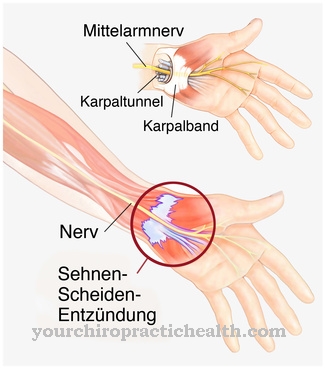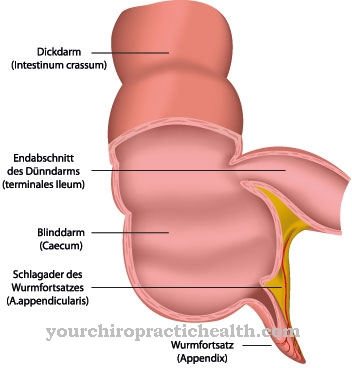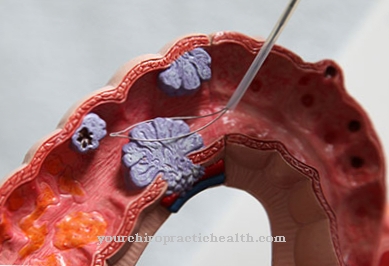At the Acrorenal Syndrome is a group of diseases that are associated with malformations of the kidneys and limbs. The acrorenal syndrome exists in the affected people from birth and is characterized by an autosomal recessive inheritance. Acrorenal syndrome is relatively rare.
What is acrorenal syndrome?

Acrorenal syndrome is a congenital disease that occurs with extremely low frequency in the population. Currently only about 20 people are known to have acrorenal syndrome. In addition to a rare hereditary disease, acrorenal syndrome is also a collective term for congenital anomalies of the limbs and kidneys, which are far more common.
The estimated prevalence of such defects is currently around 1:20 000. Statistical studies of patients show that malformations of the extremities are also associated with abnormalities in the urinary tract and other internal organs in more than 90 percent of cases. Acrorenal syndrome was first described in 1969 by the two physicians Opitz and Dieker.
A connection between malformations of the limbs and defects of the kidney seems to be relatively common. The corresponding disorders already exist at birth. Sometimes other deformities appear on the body of the newborn baby. The actual acrorenal syndrome occurs with a prevalence of about 1: 1,000,000. Doctors assume an autosomal recessive inheritance.
causes
Acrorenal syndrome is a hereditary disease that manifests itself in malformations of the limbs and kidneys. The patients have certain genetic mutations that lead to the manifestation of the typical symptoms of acrorenal syndrome.
The genetic mutations that cause the pathogenesis take place on the gene locus 15q13-q14. As a result of these genetic defects, the extremities and kidneys develop incorrectly, so that the defects are present at the time the patient is born.
Symptoms, ailments & signs
When it comes to the symptoms of the disease, a distinction must be made between the acrorenal syndrome as a collective term for various malformations and the actual acrorenal syndrome. In the former, patients suffer from malformations of the kidneys and limbs as well as other disorders. The affected persons have, for example, split hands or feet, a metatarsals and a metacarpals.
Sometimes there is oligodactyly, polydactyly, ectrodactyly and brachydactyly. Bony connections between phalanges, malformations of the ureter and renal agenesis are also possible. In addition, some patients suffer from bilateral hypoplasia of the kidneys, obstruction of the bladder neck, double kidneys or malformations of the urinary bladder triangle.
In addition, some people have symptoms such as hypertelorism, coloboma, physical growth disorders and hypoplasia of the helix. In addition, there is sometimes a psychomotor disability, clinodactyly and coarctation of the aorta. Symptoms such as coxa valga, hypoplasia of the tooth enamel and hypospadias may also appear.
The acrorenal syndrome itself usually manifests itself in a hypoplasia or agenesis of the kidneys, an ectrodactyly as well as hypoplasia of the tibia, ulna and radius. In rare cases, cyst kidneys are present. Most patients with acrorenal syndrome generally die a short time after birth due to poor kidney function. In addition, the majority of the children affected are born dead.
Diagnosis & course
Numerous malformations that occur in the context of the acrorenal syndrome can already be seen at the birth of the infants. That is why a diagnosis is usually made immediately after delivery. Even if many children with acrorenal syndrome are born dead, a diagnosis of the disease is necessary.
Various medical specialists work together, such as orthopaedists and specialists in internal medicine. When the newborn patient is examined, the custodians are usually present. The typical combination of physical deformities indicates the acrorenal syndrome. To confirm the diagnosis, the doctor carries out an X-ray examination.
Numerous anatomical anomalies, such as those in the limbs, can be identified. Nowadays, prenatal diagnosis of acrorenal syndrome is also possible. For this purpose, the attending physician performs a fine ultrasound in the uterus of the expectant mother. Certain malformations are already detectable in this way.
When should you go to the doctor?
As a rule, this syndrome is diagnosed in various examinations before birth or directly after birth. For this reason, it is usually not necessary for the parents to specifically consult a doctor, as treatment must always take place immediately after the birth. Since those affected suffer from malformations of the kidneys, these organs must be particularly monitored or spared. Should there be kidney problems, a doctor must be consulted immediately.
A psychological or motor impairment of the patient can also indicate the syndrome. In this case too, an examination and treatment by a doctor must take place. A doctor must also be consulted in the case of noticeable disorders of physical growth. Unfortunately, in most cases it is not possible to have treatment for this syndrome. Those affected can only receive palliative support.
Eventually the child dies. Not infrequently, however, the children's parents also need treatment by a psychologist. Should it come to depression or other psychological upsets, a psychologist should also be consulted.
Doctors & therapists in your area
Treatment & Therapy
It is not possible to treat the cause of the acrorenal syndrome. This is because the disease is congenital and cannot be influenced postnatally, especially since most patients die after birth at the latest. Symptomatic treatment approaches for acrorenal syndrome are also difficult.
Due to the malformations of the kidneys, most patients with acrorenal syndrome suffer from pronounced kidney weakness. In the majority of cases, kidney failure is the cause of death. Often, only palliative care is possible for the infants.
Genetic counseling in family planning is strongly recommended for families with corresponding gene mutations. Statistical evaluations indicate that the acrorenal syndrome occurs more frequently in consanguineous connections.
Outlook & forecast
This syndrome usually results in various malformations and deformities on the patient's body. These occur directly during the development of the fetus and are not acquired during the course of the disease. In many cases, the parents and relatives of the patient also suffer from the psychological stress caused by the syndrome.
The affected person has abnormalities in their hands and feet, which usually lead to restricted mobility. As a result, the patient's everyday life is restricted and those affected are often dependent on the help of other people in everyday life. The kidneys are also affected by malformations, causing disorders and pain. In the worst case, kidney failure occurs.
The growth of the body is also restricted by the disease. As a rule, direct and causal treatment of the syndrome is also not possible, so that only the child's pain can be alleviated.
prevention
It is not possible to prevent the genetic causes of acrorenal syndrome. Using prenatal examination methods, however, the acrorenal syndrome can usually already be detected in embryos in the womb. For this purpose, the doctor uses a fine ultrasound procedure in which he focuses on the extremities and the kidneys.
You can do that yourself
If the child suffers from acrorenal syndrome, it is a great burden for the parents. The child is usually unable to eat independently or use the toilet. In addition, mental disabilities, growth disorders and various malformations can also occur.
The complex symptom picture usually means a great deal of uncertainty for the relatives, because further symptoms often develop in the course of life, which increasingly restrict the child. In order to reduce the physical and mental strain, a caregiver should be called in early on who can look after the child around the clock. In addition, psychological care is available for the relatives.
In addition to these general measures, which improve the quality of life for children and parents in the long term, various organizational tasks must be carried out. This includes registering in special kindergartens and schools, making changes in the household and purchasing the necessary aids (crutches, wheelchairs, etc.). The doctor can support the parents in these steps and give tips on how to cope with the various tasks and enable the child to live a symptom-free life despite the illness.
























.jpg)



